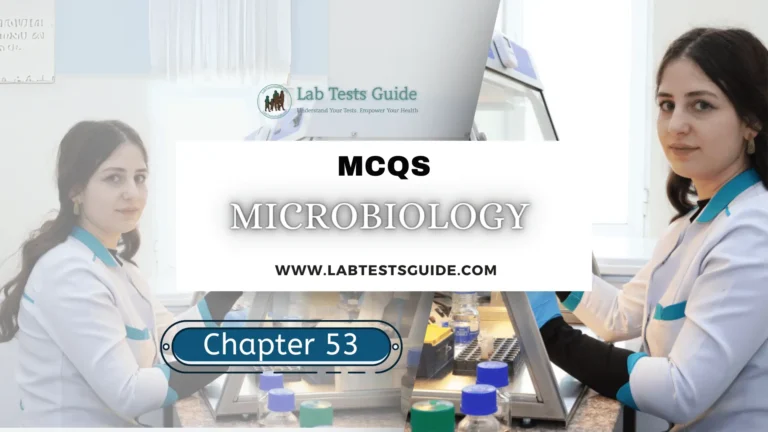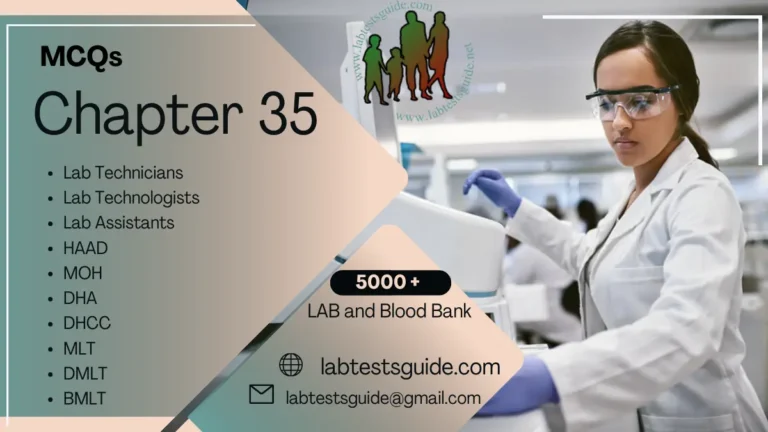5000 Plus MCQs for Lab Technician and Technologists are designed to test the knowledge and proficiency of laboratory professionals who work in the field of clinical laboratory science. These questions cover a wide range of topics related to laboratory science, including anatomy, physiology, microbiology, chemistry, and hematology.

2001 to 2050 MCQs for Lab Technician and Technologist Exam Preparation
If You like then share this to your friends and other social media.
If You have any question and suggestions then please Contact us Here
Questions 2001 to 2050
- Temperature range used for autoclaving is….
- 100°C for 10 min
- 100°C for 30 min
- 121°C for 15 min ✔
- 121°C for 30 min
- ELISA is used for the diagnosis of
- AIDS ✔
- Night blindness
- Sickle cell anaemia
- All of the above
- Name the first organic acid produced by microbial fermentation.
- Acetic acid
- Lactic acid ✔
- Butyric acid
- None of the above
- The most common viral cause of gastroenteritis:
- Rotavirus ✔
- Norwalk virus
- Adenovinis
- Hepadnavirus
- All are true about SARS EXCEPT:
- Epidemic is seen in India ✔
- Spreads by droplet
- Diagnosed by PCR
- Caused by a type of coronavirus
- Perinatal Hepatitis B transmission is maximum in
- 1″ trimester
- 2-trimester
- 3 trimester
- During delivery ✔
- Which Hepatitis virus is associated with highest mortality in pregnancy?
- Hepatitis A
- Hepatitis B
- Hepatitis C
- Hepatitis E ✔
- Hepatitis virus that spreads by fecal-oral route:
- Hepatitis A ✔
- Hepatitis B
- Hepatitis C
- Hepatitis D
- Acute hepatitis B infection is best diagnosed by:
- HBsAg
- HBeAg
- IgM Anti HBc antobody ✔
- HBcAg
- Which parameter is not included in HAI surveillance?
- CA-UTI (catheter associated urinary tract infection)
- CLABSI (central line associated bloodstream infection)
- VAP (ventilator associated pneumonia)
- Open wound infections ✔
- Hand rub should not be used in which condition?
- Before touching patient
- After touching patient
- After touching patient’s surrounding
- Hands are visibly soiled ✔
- How many moments of hand hygiene have been laid down by WHO?
- 5 ✔
- 6
- 7
- 8
- Which antibody crosses placenta?
- IgG ✔
- IGA
- IgE
- IgM
- Which is an example of surface lg?
- IgA ✔
- IgG
- IgE
- IgM
- Type I hypersensitivity is mediated by which of the following immunoglobulins?
- IgA
- IgG
- IgM
- IgE ✔
- Wheal and flare is which type of hypersensitivity reaction:
- Type I ✔
- Type II
- Type IV
- Type V
- Type I hypersensitivity includes all of the following except:
- Autoimmune hemolytic anemia ✔
- Anaphylaxis
- Extrinsic asthma
- Hay fever
- A positive tuberculin test is an example of:
- Type I hypersensitivity
- Type Il hypersensitivity
- Type IlI hypersensitivity
- Type IV hypersensitivity ✔
- Application of skin graft for the second time from the same donor will result in:
- First set rejection
- Second set rejection ✔
- Both
- None
- Transplantation between members with same genetic constitution is known as:
- Autograft
- Isograft ✔
- Allograft
- Xenograft
- All of the following are live-attenuated vaccines except:
- MMR
- Yellow fever 17D vaccine
- Salk polio vaccine ✔
- Sabin polio vaccine
- Amphitrichous flagella means
- Flagella all-round the cell
- Flagella at both ends ✔
- Flagella at one end
- Flagella in tufts
- When Flagella is present all around the cell it is called
- Amphitrichous
- Monotrichous
- Peritrichous ✔
- Lopotrichous
- India ink is used to demonstrate the following part of bacteria
- Cell wall
- Nucleus
- Capsule ✔
- Flagella
- Reflected light is used in
- Light microscope
- Phase contrast microscope
- Darkfield microscope ✔
- Electron microscope
- Bacteria that grow between 25 to 40’C are
- Capnophilic
- Psychrophilic
- Thermophilic
- Mesophilic ✔
- Shape of cocci
- Rod
- Spherical ✔
- Comma
- Spiral
- Best way of sterilizing disposable plastic syringes is:
- UV rays
- Autoclave
- Gamma rays ✔
- Hot air oven
- The most suitable disinfectant for decontamination of HIV contaminated endoscope is (MAH19)
- 1% sodium hypochlorite
- 2% glutaraldehyde ✔
- 5% phenol
- 70% ethanol
- Flexible fibre optic endoscopes are sterilized by
- Autoclave
- Cetrimide
- 2% glutaraldehyde ✔
- Gamma-radiation
- Which of the following organism can survive pasteurization by Holder method?
- Mycobacterium
- Brucella
- Coxiella burnetii ✔
- Salmonella
- Temperature and duration for flash process of Pasteurization
- 77″ for 20 seconds ✔
- 100°C for 20 seconds
- 63°C for 20 seconds
- 63C for 30 minutes
- Sterilization of heat labile media is done by
- Filtration
- Pasteurization
- Autoclaving
- Tyndalization ✔
- Immunoglobulin that is inactivated at high temperature
- IgG
- IgA
- Ig?
- IgE ✔
- Immunoglobulins are
- Glycolipids
- Glycoproteins ✔
- Polypeptides
- Proteoglycans
- Exotoxins are usually
- Protein ✔
- Heat labile
- More antigenic
- Non-enzymatic
- True about exotoxins
- Produced only by gram positive bacteria
- Neutralized by antitoxin ✔
- Less potent than endotoxin
- Pyrogenic
- The function of an adjuvant in a vaccine is to enhance its:
- Distribution
- immunogenicity ✔
- Absorption
- Shelf life
- The Immunity resulting in the infant, as a result of immunization of a pregnant woman with tetanus tosold is called
- innate immunity
- Natural active immunity
- Artificial active immunity
- Natural passive immunity ✔
- Anti-D given to a Rh negative pregnant woman with Rh?positive fetus, before delivery is an example of
- Artificial active immunity
- Artificial passive immunity ✔
- Natural passive immunity
- Adoptive immunity
- Gram-positive bacterials which is usually sensitive to penicilinis
- Staphylococcus aureus
- Enterococcus faecalis
- Streptococcus pyogenes ✔
- Staphylococcus epidermidis
- Streptococ causing neonatal meningitis
- Group-A
- Group-B ✔
- Group-C
- Group-D
- Which of the following gram positive bacteria is responsible for food poisoning?
- Mycoplasmas
- Pseudomonas
- Clostridia ✔
- All of the above
- Methicillin resistance bacteria are
- Streptococci
- Pseudomonas
- Haemophilus
- Staphylococci ✔
- The organism causing UTI in sexually active women
- Staphylococcus aureus
- Staphylococcus epidermidis
- Staphylococcus saprophyticus ✔
- Streptococcus viridians
- Antibiotic used in Toxic shock syndrome
- Vancomycin
- Cephalosporins
- Streptomycin
- Clindamycin ✔
- Grave’s disease belongs to
- Type I hypersensitivity
- Type Il hypersensitivity ✔
- Type III hypersensitivity
- Type IV hypersensitivity
- Type of hypersensitivity involved in Rh incompatibility
- Type i hypersensitivity
- Type ii hypersensitivity ✔
- Type iii hypersensitivity
- Type iv hypersensitivity
- Chemically an antigen may be
- Lipid
- Polysaccharide
- Protein
- Any of the above ✔
- Example of cell mediated hypersensitivity
- Transfusion reactions
- Arthus reactions
- Type Il lepra reaction
- Tuberculin test ✔
The questions are typically designed to assess the technical skills and knowledge required for the laboratory profession, including the ability to analyze laboratory test results, perform laboratory procedures, and maintain laboratory equipment.
To prepare for these MCQs, candidates should have a thorough understanding of the key concepts and principles of laboratory science. They should also be familiar with common laboratory equipment and procedures, as well as laboratory safety protocols.
Candidates may also benefit from studying specific laboratory science textbooks or taking online courses that cover the material tested in the MCQs. Additionally, practicing sample MCQs and reviewing the answers can help candidates identify areas where they may need to improve their knowledge or skills.
Overall, the MCQs for lab technologists are designed to be challenging and comprehensive, requiring candidates to demonstrate a high level of proficiency in the field of laboratory science.
Possible References Used






